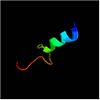Mycobacterium tuberculosis ArfA Rv0899
From Proteopedia
(Difference between revisions)
| Line 32: | Line 32: | ||
The membrane protein Rv0899 of M. tuberculosis encoded by gene Rv0899 has been proposed to act as an outer membrane [[porin]] and to contribute to the bacterium's adaptation to the acidic environment of the phagosome[http://en.wikipedia.org/wiki/Phagosome] during infection. | The membrane protein Rv0899 of M. tuberculosis encoded by gene Rv0899 has been proposed to act as an outer membrane [[porin]] and to contribute to the bacterium's adaptation to the acidic environment of the phagosome[http://en.wikipedia.org/wiki/Phagosome] during infection. | ||
The protein is restricted to pathogenic Mycobacteria associated with TB and, thus, is an attractive candidate for the development of anti-TB chemotherapeutic agents.Two M. tuberculosis H37Rv genes (Rv0900 and Rv0901) adjacent to Rv0899 also encode putative membrane proteins, and are found exclusively in association with Rv0899 in the same pathogenic mycobacteria, suggesting that the three may constitute an operon dedicated to a common function. | The protein is restricted to pathogenic Mycobacteria associated with TB and, thus, is an attractive candidate for the development of anti-TB chemotherapeutic agents.Two M. tuberculosis H37Rv genes (Rv0900 and Rv0901) adjacent to Rv0899 also encode putative membrane proteins, and are found exclusively in association with Rv0899 in the same pathogenic mycobacteria, suggesting that the three may constitute an operon dedicated to a common function. | ||
| - | The amino acid pair Asn111-Gly112,located at the end of α1 and preceding L3, undergoes in-vitro deamidation, a pH-dependent reaction whereby Asn is converted to Asp and ammonia is released. Asparagine residues preceding glycine, and situated in conformationally flexible regions of proteins, are frequently deamidated, with potentially significant consequences for protein regulation and function. In the case of Rv0899, deamidation and the concomitant release of ammonia could have important consequences for the acid adaptation function of the protein. The gene is restricted to pathogenic mycobacteria and, thus, is an attractive candidate for the development of anti-tuberculosis chemotherapy. <ref>PMID: 20199110</ref> | + | The amino acid pair <scene name='61/612805/Asn111_and_gly112/1'>Asn111-Gly112</scene>,located at the end of α1 and preceding L3, undergoes in-vitro deamidation, a pH-dependent reaction whereby Asn is converted to Asp and ammonia is released. Asparagine residues preceding glycine, and situated in conformationally flexible regions of proteins, are frequently deamidated, with potentially significant consequences for protein regulation and function. In the case of Rv0899, deamidation and the concomitant release of ammonia could have important consequences for the acid adaptation function of the protein. The gene is restricted to pathogenic mycobacteria and, thus, is an attractive candidate for the development of anti-tuberculosis chemotherapy. <ref>PMID: 20199110</ref> |
Probably plays a role in ammonia secretion that neutralizes the medium at pH 5.5,and preceded exponential growth of ''Mycobacterium tuberculosis'', although it does not play a direct role in ammonia transport.[[http://www.uniprot.org/uniprot/P9WIU5 ARFA_MYCTU]]. The ompATb operon is necessary for rapid ammonia secretion and adaptation of M. tuberculosis to acidic environments in vitro but not in mice. | Probably plays a role in ammonia secretion that neutralizes the medium at pH 5.5,and preceded exponential growth of ''Mycobacterium tuberculosis'', although it does not play a direct role in ammonia transport.[[http://www.uniprot.org/uniprot/P9WIU5 ARFA_MYCTU]]. The ompATb operon is necessary for rapid ammonia secretion and adaptation of M. tuberculosis to acidic environments in vitro but not in mice. | ||
<ref>PMID: 21410778 </ref> | <ref>PMID: 21410778 </ref> | ||
| Line 44: | Line 44: | ||
| - | + | ||
<scene name='61/612805/The_peptidoglycan_binding_site/1'>The peptidoglycan binding site</scene> | <scene name='61/612805/The_peptidoglycan_binding_site/1'>The peptidoglycan binding site</scene> | ||
Revision as of 17:39, 15 January 2015
| |||||||||||


